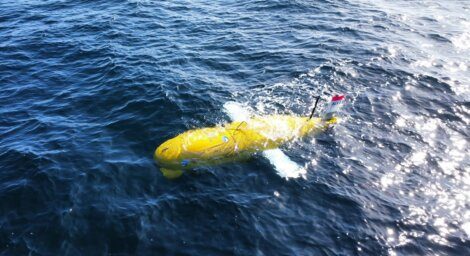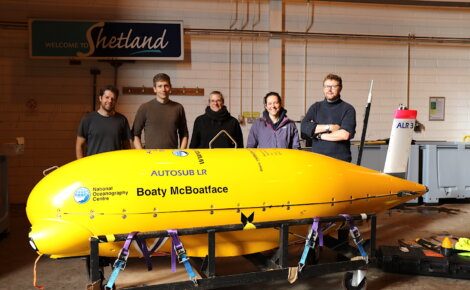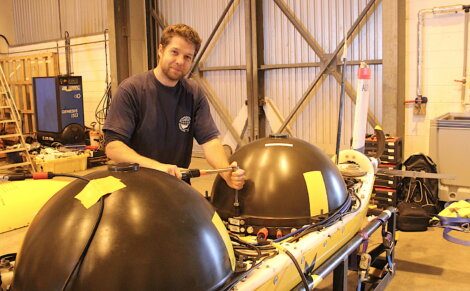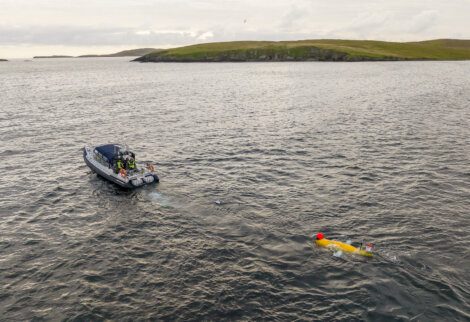Marine / Boaty McBoatface off to do survey work after Lerwick launch
THE REAL Boaty McBoatface has launched from Lerwick today (Monday) on a 12-day voyage that is set to prove the feasibility of using robot submarines for environmental surveys of decommissioned North Sea oil fields.
Scientists from the National Oceanographic Centre (NOC), based at the University of Southampton, arrived in Shetland on Friday to prepare for the launch of the 3.6-metre-long autonomous long-range submarine.
Originally planned for Sunday the launch from a Lerwick quayside had to be postponed by 24 hours due to the high northerly swell.
The yellow submarine will travel to the decommissioned site of Northwest Hutton, about 130 kilometres to east of the isles, autonomously survey the area, then return to Lerwick for recharging and for scientists to recover the data collected.
The autosub lang range (ALR) vehicle will then venture to the decommissioned site of the Miller oil field, located to the southeast of Shetland, to repeat the exercise. While in the area the ocean robot will also carry out an environmental survey of the Braemar Pockmarks, a marine protected area.
When in 2016 the Natural Environment Research Council launched an online poll to name a new polar research ship, and more than 32,000 names were put forward – with the joke moniker Boaty McBoatface winning the competition.
Become a member of Shetland News
However, the powers that be eventually opted to name the new vessel Sir David Attenborough to mark the famous naturalist’s 90th birthday.
But Boaty McBoatface lives on as the name of one of the vessel’s advanced autonomous submarines, capable of diving to water depths of 6,000 metres.
Scientists who have worked on the submarine project for many years were initially not too chuffed about the fun name, but are now recognising that the eye-catching title will also help to raise their profile.
The underwater vehicle’s mechanical engineer Robert Templeton, who has been working on the project since 2015, said it will be the first time the team has sent out the vehicles for such a long time on rechargeable batteries.
“The submarine will be under water for 24 hours, pops up to check its navigation via GPS, communicate with us and we will send it on the next leg of the mission,” he said.
“We have sent these vehicles under ice shelves for three or four days at a time.”
Once at Northwest Hutton, the ALR will turn on all of its sensors and will survey the area at a five metre altitude above the bottom, taking photos.
“That will take several days, then we will bring it back,” Templeton said. “The journey will take about 12 days. We will plug it in, charge it back up and then send it out again to do the next leg.”
The submarine will collect data on the distribution of animals, take photos, measuring currents, salinity and temperature, while it has hydrocarbon sensors that can measure any oil or gas in the water.
The project’s science lead Dr Daniel Jones said that if successful autonomous surveying of decommissioned oil field sites could at least partly replace the expensive and time-consuming survey work from ships.
“By launching it from shore we can extend its range and go to different sites in one mission, and we don’t need the ship,” he said.
“Northwest Hutton and Miller are fairly representative of decommissioned sites, and there is some infrastructure still in place on the seabed floor.”
Oil companies are required to do impact checking and carry out environmental monitoring which has to be done on a frequent basis.
“Hopefully we can replace that activity with the autonomous approaches using this technique,” Dr Jones said.
“But we don’t know if we can do that at the moment. So, the key part is first do demonstrate that it is possible, and second, that data that we are collecting is comparable to the data that they have already done.
“What this means is that it might collect more data, more quickly, and more regularly, so rather than doing a survey every five years they might be able to do it every two years, and multiple site at the same time – to better understand the environment, and hopefully reducing the chances of pollution events spreading.
“I don’t think it will ever replace completely the standard approach of using ships and people. There will still be a need for that, but a big element of this work can be done in this autonomous way.”
He added: “The reason for coming to Shetland is that it is the closest place to do this. It’s an ideal hub for this kind of work, (…) it’s perfect for a shore launch.”
Become a member of Shetland News
Shetland News is asking its readers to consider paying for membership to get additional perks:
- Removal of third-party ads;
- Bookmark posts to read later;
- Exclusive curated weekly newsletter;
- Hide membership messages;
- Comments open for discussion.
If you appreciate what we do and feel strongly about impartial local journalism, then please become a member of Shetland News by either making a single payment, or setting up a monthly, quarterly or yearly subscription.














